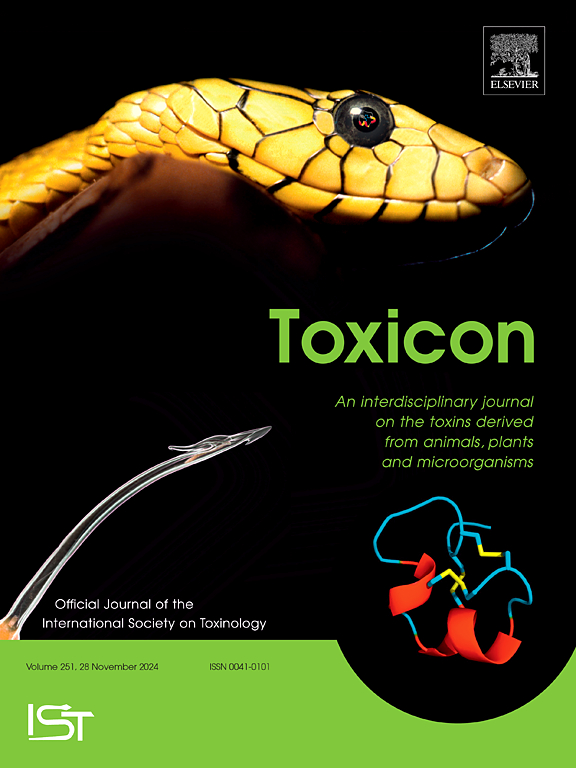AI models uncover factors influencing scorpionism in Northern Brazil
IF 2.6
4区 医学
Q2 PHARMACOLOGY & PHARMACY
引用次数: 0
Abstract
Envenomation by scorpion stings is a serious public health problem in tropical regions of the world. In Brazil's Northern region, there has been a significant increase in cases over the last decade, accompanied by a rise in the fatality rate. Climate change and intensive land use are altering the distribution of species that pose health risks and may be associated with the increased incidence of accidents. We integrated species distribution models (SDMs) of three medically important species (Tityus obscurus, T. metuendus, and T. silvestris), bioclimatic data, and land use to predict scorpionism incidence and quantify the importance of predictors in Northern Brazil. We used these predictors to build a model to predict the incidence of scorpion envenomations using the XGBoost artificial intelligence (AI) algorithm and assessed the importance of the predictor variables with the Shapley method.Our models demonstrated good performance in predicting incidence, with a MAE of 7.17 and an RMSE of 10.62. The analysis identified that climatic factors are the main determinants of incidence but also highlighted the relevance of the distribution of T. obscurus and T. silvestris species, pasture areas, and rural population density. The study showed that integrating SDMs and AI techniques is effective for predicting scorpionism incidence and assisting in the formulation of prevention as well as management strategies.

人工智能模型揭示了影响巴西北部蝎子病的因素
蝎子蜇伤是世界热带地区一个严重的公共卫生问题。在巴西北部地区,过去十年来病例显著增加,同时死亡率也有所上升。气候变化和土地集约利用正在改变构成健康风险的物种的分布,并可能与事故发生率增加有关。我们综合了三种医学上重要的物种(Tityus obscurus、T. metuendus和T. silvestris)的物种分布模型(SDMs)、生物气候数据和土地利用来预测巴西北部蝎子病的发病率,并量化了预测因子的重要性。我们利用这些预测变量建立了一个模型,使用XGBoost人工智能(AI)算法预测蝎子中毒的发生率,并使用Shapley方法评估预测变量的重要性。我们的模型在预测发病率方面表现良好,MAE为7.17,RMSE为10.62。分析表明,气候因素是影响黑斑田鼠和银斑田鼠发病率的主要因素,但也强调了黑斑田鼠和银斑田鼠物种分布、牧场面积和农村人口密度的相关性。研究表明,整合SDMs和AI技术对于预测蝎子病的发病率和协助制定预防和管理策略是有效的。
本文章由计算机程序翻译,如有差异,请以英文原文为准。
求助全文
约1分钟内获得全文
求助全文
来源期刊

Toxicon
医学-毒理学
CiteScore
4.80
自引率
10.70%
发文量
358
审稿时长
68 days
期刊介绍:
Toxicon has an open access mirror Toxicon: X, sharing the same aims and scope, editorial team, submission system and rigorous peer review. An introductory offer Toxicon: X - full waiver of the Open Access fee.
Toxicon''s "aims and scope" are to publish:
-articles containing the results of original research on problems related to toxins derived from animals, plants and microorganisms
-papers on novel findings related to the chemical, pharmacological, toxicological, and immunological properties of natural toxins
-molecular biological studies of toxins and other genes from poisonous and venomous organisms that advance understanding of the role or function of toxins
-clinical observations on poisoning and envenoming where a new therapeutic principle has been proposed or a decidedly superior clinical result has been obtained.
-material on the use of toxins as tools in studying biological processes and material on subjects related to venom and antivenom problems.
-articles on the translational application of toxins, for example as drugs and insecticides
-epidemiological studies on envenoming or poisoning, so long as they highlight a previously unrecognised medical problem or provide insight into the prevention or medical treatment of envenoming or poisoning. Retrospective surveys of hospital records, especially those lacking species identification, will not be considered for publication. Properly designed prospective community-based surveys are strongly encouraged.
-articles describing well-known activities of venoms, such as antibacterial, anticancer, and analgesic activities of arachnid venoms, without any attempt to define the mechanism of action or purify the active component, will not be considered for publication in Toxicon.
-review articles on problems related to toxinology.
To encourage the exchange of ideas, sections of the journal may be devoted to Short Communications, Letters to the Editor and activities of the affiliated societies.
 求助内容:
求助内容: 应助结果提醒方式:
应助结果提醒方式:


